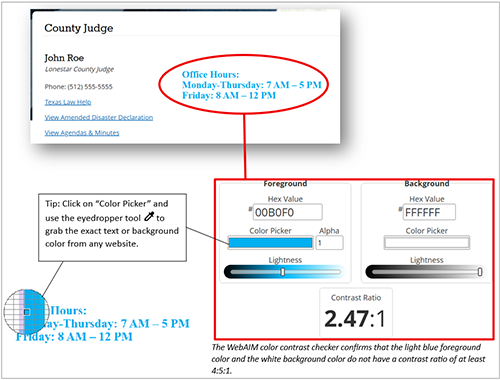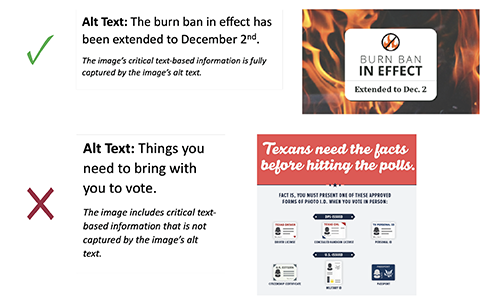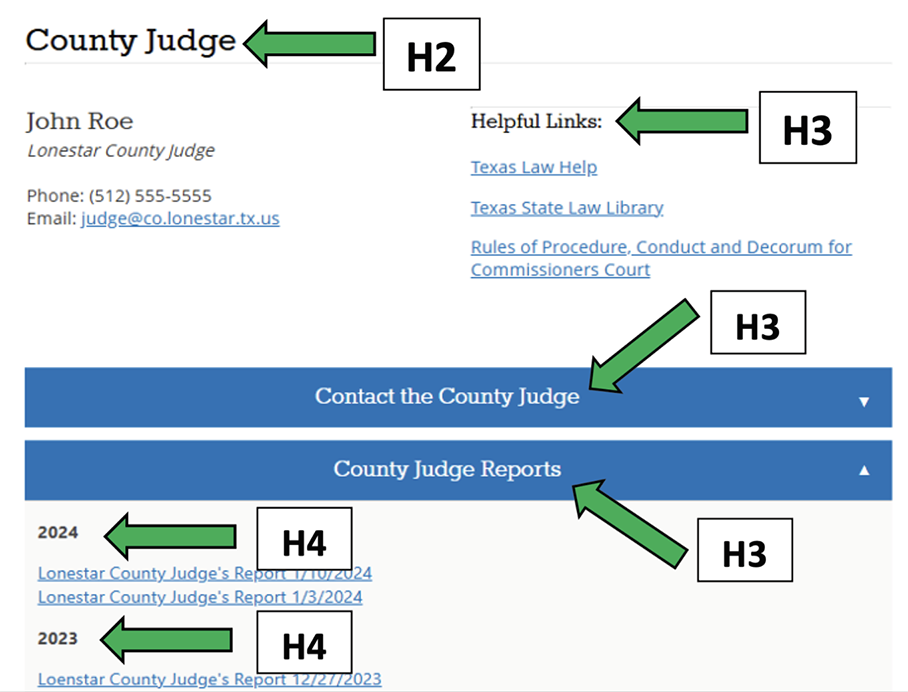Programs
Step-by-Step Guide to Website Accessibility
 TAC CIRA is providing a step-by-step guide to website accessibility coordinators and any other county officials or employees interested in learning more about website accessibility best practices. The guide is based on the Department of Justice’s action steps. If you haven’t already, join the mailing list. If you’re just getting started, find the key steps below that will help you catch up. Questions? Contact CIRA Support.
TAC CIRA is providing a step-by-step guide to website accessibility coordinators and any other county officials or employees interested in learning more about website accessibility best practices. The guide is based on the Department of Justice’s action steps. If you haven’t already, join the mailing list. If you’re just getting started, find the key steps below that will help you catch up. Questions? Contact CIRA Support.
Make sure you understand the Department of Justice’s final rule and what’s expected to make your website accessible.
Key takeaways
- Understand the rule
- Compliance deadlines
- Local governments with a population of 50,000 or more:
Compliance deadline: April 24, 2026 - Local governments with a population up to 49,999:
Compliance deadline: April 26, 2027
- Local governments with a population of 50,000 or more:
- Learn about the technical standard
Action for today
Read through the requirements and consider your deadline. And don’t worry – we will be providing training resources in a future step!
Want to test your knowledge?
Take our accessibility quiz!
Your county should designate at least one web accessibility coordinator, who will serve as the main point of contact on web accessibility issues and post an accessibility statement.
What you need to do
- Identify key roles: Determine who within your county will be responsible for ensuring compliance, including IT staff, web developers, procurement staff and others who may play a role in accessibility.
- Set clear expectations: Assign specific responsibilities to relevant staff and create a culture of accessibility by clearly defining roles to avoid confusion. This should include who is responsible for developing and publishing accessible content (including PDFs and other files) to your website.
- Accessibility Statement: Add an accessibility statement to your site. This statement should explain that your website follows ADA accessibility guidelines and provide a way for users to report issues. If you’re a CIRA member, we can post an accessibility statement for you. If not, check out W3C’s resources.
Action for Today:
If you’re not a website accessibility coordinator for your county, make sure they get these emails by joining our mailing list!
Making a website accessible requires time and resources. Some changes can be made in-house, but others may require outside help. With budget season in full swing, this is a good time to set aside budget money for web accessibility.
Budget resources
- Accessibility expert Kris Rivenburgh offers budgeting tips in a recent episode of the Texas County Voice podcast.
Providing regular training for staff ensures they are equipped to create, review and update content that improves access for all constituents.
Resources:
- The General Services Administration and Web Accessibility Initiative offer online courses and training videos.
- Accessibility expert Kris Rivenburgh explains web accessibility fundamentals and busts web accessibility myths on the TAC CIRA training page.
What you need to do
- Add descriptive link text. Ensure that each hyperlink is clear and describes the content users will access when they click it. For example, instead of "click here," use "Read more about our upcoming events."
- Keep consistent formatting. Make sure all links are formatted the same way. If one link is underlined and another is bold, some users may have difficulty recognizing them.
- Avoid using all capital letters in hyperlink text. This can hinder readers with visual impairments.
Are you a CIRA Website Member wanting more information about adding hyperlinks to your website? See the CIRA Web Training Resource Hub. Reach out to CIRA for website credentials.
What you need to do
- Update Document Links: When linking to PDFs and other documents, make sure the file type is clearly indicated. Example: “Download the report (PDF).”
- Add Alternative Text to Meaningful Images: Alt text is a short, descriptive phrase that helps blind and visually impaired people understand what an image conveys.

For more information about accessibility best practices, watch Kris Rivenburgh’s webinar on the TAC YouTube channel.
Color contrast is essential for readability, especially for users with low vision or color blindness. Images with text can be problematic because they can’t be read by screen readers.
What You Need to Do:
- Color Contrast: Make sure there’s enough contrast between the text and the background. Use tools like WebAIM’s contrast checker to test your website’s color schemes.

- No Critical Text in Images: Avoid using images that include text conveying important information. If you must, provide the text separately elsewhere on the page.

- Color should not be the only way to convey importance. For example, if a form field needs to be filled out, don’t just rely on a red border — also include a text label or symbol to make sure users with color blindness can understand it.

- Use proper heading levels (H1, H2, H3) to organize your website’s content. This creates a clear hierarchy and helps users (including those with screen readers) navigate your content more easily. You’ll find the headings function in the web editing toolbar.

As your website grows and changes, it’s important to regularly review and archive content to make sure it remains accessible.
What You Need to Do:
- Content Review: Set up a regular content review process to make sure your content is still accessible. There are free tools, like the WAVE plugin, that can help identify new issues and keep your website ADA compliant.
- Archiving: If older content is moved to an archive, make sure users can still find it. Archived content is exempt from web accessibility requirements if it meets all four of these criteria:
- The content was created before the compliance date.
- The content is only kept for reference, research or recordkeeping.
- It’s stored in a dedicated archive.
- It has not been changed since it was archived.
TAC CIRA can archive web pages for members. Fill out our archiving form for assistance.
Exceptions might apply when it’s technically impossible or too costly to comply with specific accessibility features. However, it’s crucial to provide a reasonable alternative to ensure everyone can access your content.
When not to comply: If compliance would cause an undue burden, you may be excused. However, this requires a strong justification. In most cases, you’ll need to post a disclaimer to your website explaining why the page does not meet ADA requirements.
What You Need to Do:
- Learn about the exceptions to accessibility rules and watch Kris Rivenburgh’s webinar about website accessibility.
- Review your website and determine if there are any exceptions that apply. Make sure that if an exception is claimed, you have a reasonable alternative in place to meet users’ needs.
Let’s talk about how you can prioritize your web accessibility updates.
What You Need to Do:
- Fix the biggest accessibility barriers first, such as missing alt text and poor contrast.
- Identify the quick wins. It doesn’t take long to fix broken links and add alt text to images. Tackle these first to build momentum.
- Create a timeline for the fixes you need to make and track your progress. Don’t feel like you need to fix everything at once.
Here are some tools and resources that can help your website remain compliant.
What You Need to Do:
- Download an accessibility audit tool, such as WAVE, AXE or Google Lighthouse. These programs scan your website for issues and generate a list of solutions. Use the tool often, so that you can stay on top of any issues that may arise.
- Establish accessibility policies for ongoing website management. This will ensure that future content is always accessible.

